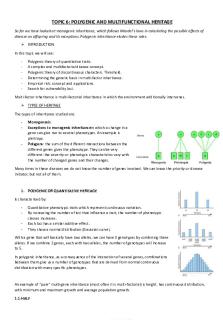6- v SIMs Complex - Lecture notes 6 PDF

| Title | 6- v SIMs Complex - Lecture notes 6 |
|---|---|
| Course | Complex Nursing Care |
| Institution | Algonquin College |
| Pages | 2 |
| File Size | 74.9 KB |
| File Type | |
| Total Downloads | 29 |
| Total Views | 196 |
Summary
Nursing practice in complex care situations with individuals, groups and or communities. Nursing management of complex health, family, community or social issues in community, primary, or tertiary care settings....
Description
SIM 6 Surgical Case: Vernon Watkins Documentation Assignments
1. Document Vernon Watkins’ respiratory assessment that occurred in the case. During my initial respiratory assessment, the patient's respirations were 24 (tachypnea), SpO2 was 93%, the chest was moving normally on both sides, and the breath sounds were normal. However, the patient expressed that he had chest pain and it was painful to breathe.
2. Document the actions during the acute respiratory distress episode. During the acute respiratory distress episode, I sat the patient up and gave oxygen to improve the SpO2, listened to the lung sounds, and called the provider to discuss the patient. Then I obtained a chest x-ray, a spiral CT scan of the chest, arterial blood sample, 12-lead ECG, and administered heparin as per physician orders. Finally, I reassessed the patient's pain and vital signs.
3. Document the changes in Vernon Watkins’ vital signs throughout the scenario. INITIAL ASSESSMENT: Patient status - ECG: Sinus tachycardia with signs of pulmonary hypertension. Heart rate: 103. Pulse: Present. Blood pressure: 150/89 mm Hg. Respiration: 25. Conscious state: Appropriate. SpO2: 96%. Temp: 99 F (37 C) Pain: 3
DURING ASSESSMENT: Patient status - ECG: Sinus tachycardia with signs of pulmonary hypertension. Heart rate: 110. Pulse: Present. Blood pressure: 155/92 mm Hg. Respiration: 24. Conscious state: Appropriate. SpO2: 92%. Temp: 99 F (37 C)
BEFORE HANDOFF: Patient status - ECG: Sinus tachycardia with signs of pulmonary hypertension. Heart rate: 110. Pulse: Present. Blood pressure: 154/92 mm Hg. Respiration: 24. Conscious state: Appropriate. SpO2: 92%. Temp: 99 F (37 C) Pain: 3
1
SIM 6
4. Identify and document key nursing diagnoses for Vernon Watkins. Key nursing diagnoses for Vernon Watkins can include: -
Impaired gas exchange related to decreased pulmonary perfusion as evidenced by dyspnea and pulmonary embolism.
-
Ineffective breathing pattern related to pulmonary embolism as evidenced by dyspnea
5. Referring to your feedback log, document the nursing care you provided. After introducing myself, hand hygiene, patient identification, and obtaining consent, I attached a pulse oximeter and asked if he had any pain. After my pain assessment, I assessed his breathing, temperature, attached the NIBP, 3-lead ECG, and assessed the IV. Then, I sat the patient up to place a nasal oxygen cannula and turn the oxygen on as per orders. Next, I listened to the lungs and phone the provider to discuss the patient. I assessed the patients dressing, asked about any allergies, and obtained consent before obtaining a chest x-ray, spiral CT scan, arterial blood sample, 12-lead ECG, and administering heparin. After performing the doctors orders, I reassessed vital signs, pain and the respiratory system. Finally, I performed patient education and hand hygiene before hand off.
2...
Similar Free PDFs

Complex Arguments 6
- 5 Pages

Ch 6 - Lecture notes 6
- 3 Pages

Chapter 6 - Lecture notes 6
- 5 Pages

Module 6 - Lecture notes 6
- 2 Pages

Chapter 6 - Lecture notes 6
- 6 Pages

Chapter 6 - Lecture notes 6
- 9 Pages

Anth101 6 - Lecture notes 6
- 4 Pages

Chapitre 6 - Lecture notes 6
- 2 Pages

Lec 6 - Lecture notes 6
- 3 Pages

Ch 6 - Lecture notes 6
- 4 Pages

Chapter 6 - Lecture notes 6
- 11 Pages

Unit 6 - Lecture notes 6
- 7 Pages

Assignment 6 - Lecture notes 6
- 5 Pages

Experiment 6 - Lecture notes 6
- 4 Pages

CIV1000 - 6 - Lecture notes 6
- 3 Pages
Popular Institutions
- Tinajero National High School - Annex
- Politeknik Caltex Riau
- Yokohama City University
- SGT University
- University of Al-Qadisiyah
- Divine Word College of Vigan
- Techniek College Rotterdam
- Universidade de Santiago
- Universiti Teknologi MARA Cawangan Johor Kampus Pasir Gudang
- Poltekkes Kemenkes Yogyakarta
- Baguio City National High School
- Colegio san marcos
- preparatoria uno
- Centro de Bachillerato Tecnológico Industrial y de Servicios No. 107
- Dalian Maritime University
- Quang Trung Secondary School
- Colegio Tecnológico en Informática
- Corporación Regional de Educación Superior
- Grupo CEDVA
- Dar Al Uloom University
- Centro de Estudios Preuniversitarios de la Universidad Nacional de Ingeniería
- 上智大学
- Aakash International School, Nuna Majara
- San Felipe Neri Catholic School
- Kang Chiao International School - New Taipei City
- Misamis Occidental National High School
- Institución Educativa Escuela Normal Juan Ladrilleros
- Kolehiyo ng Pantukan
- Batanes State College
- Instituto Continental
- Sekolah Menengah Kejuruan Kesehatan Kaltara (Tarakan)
- Colegio de La Inmaculada Concepcion - Cebu
